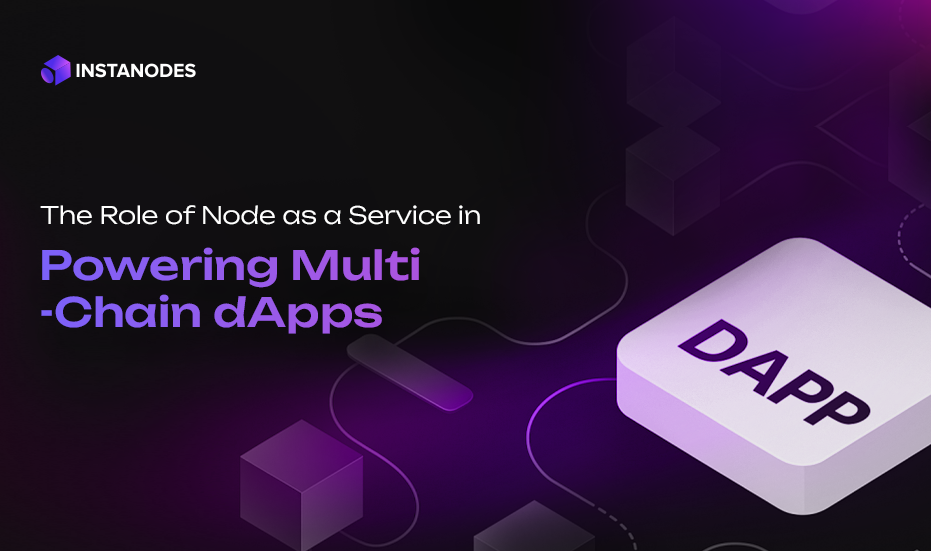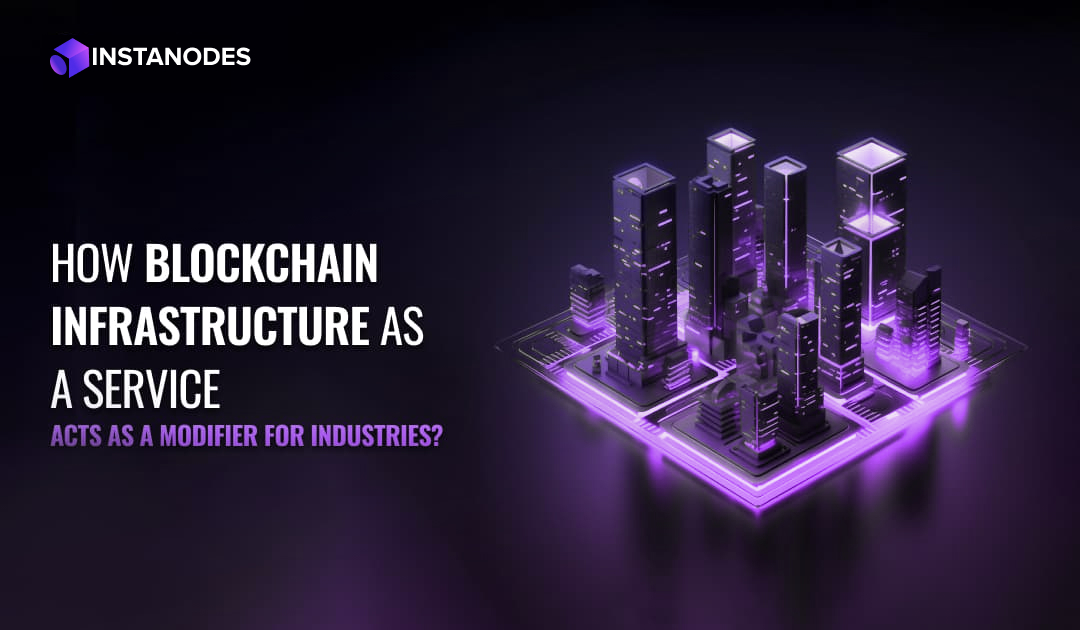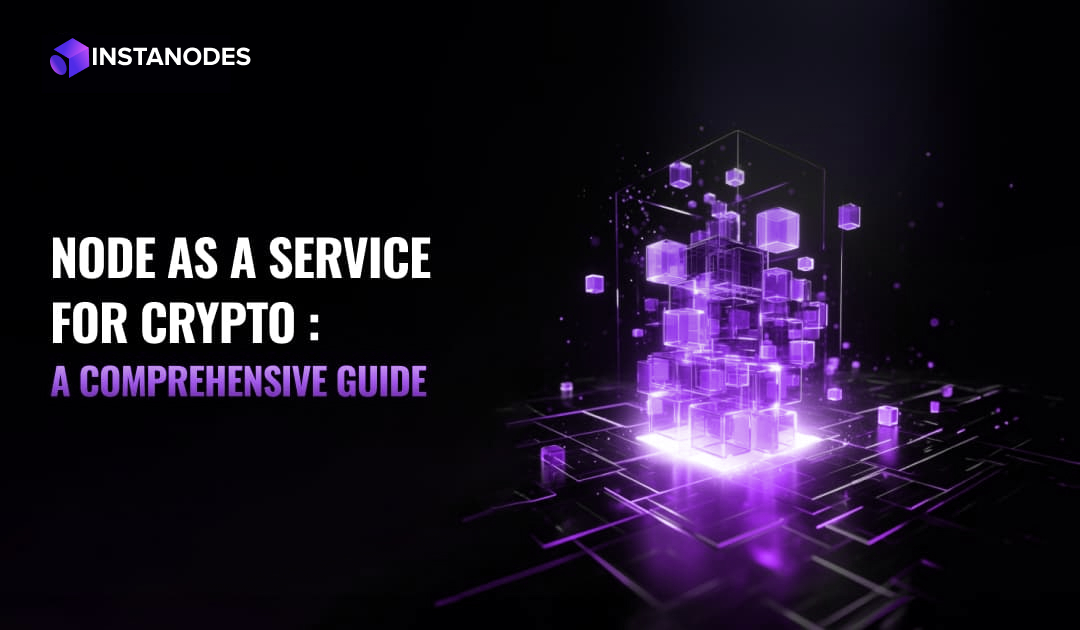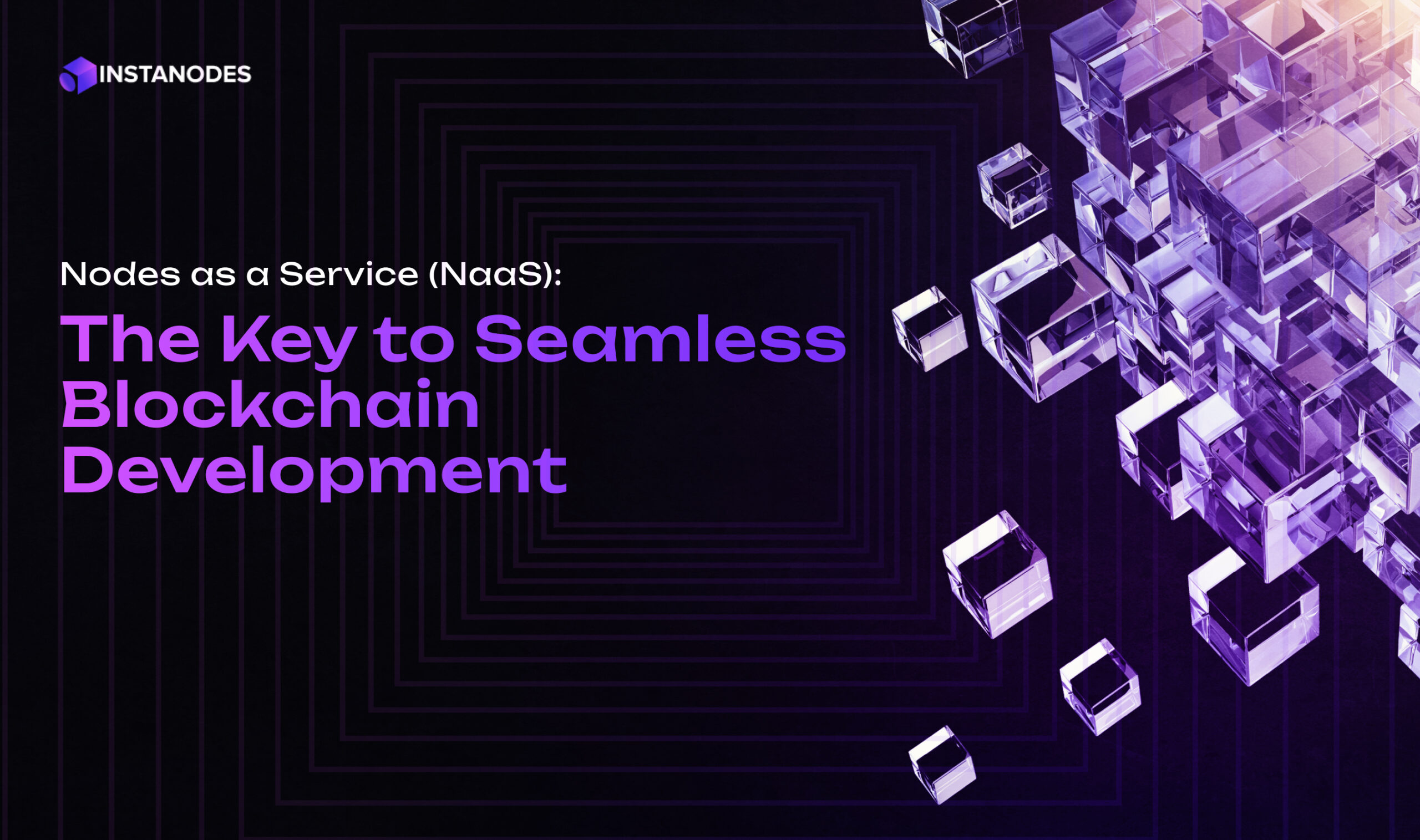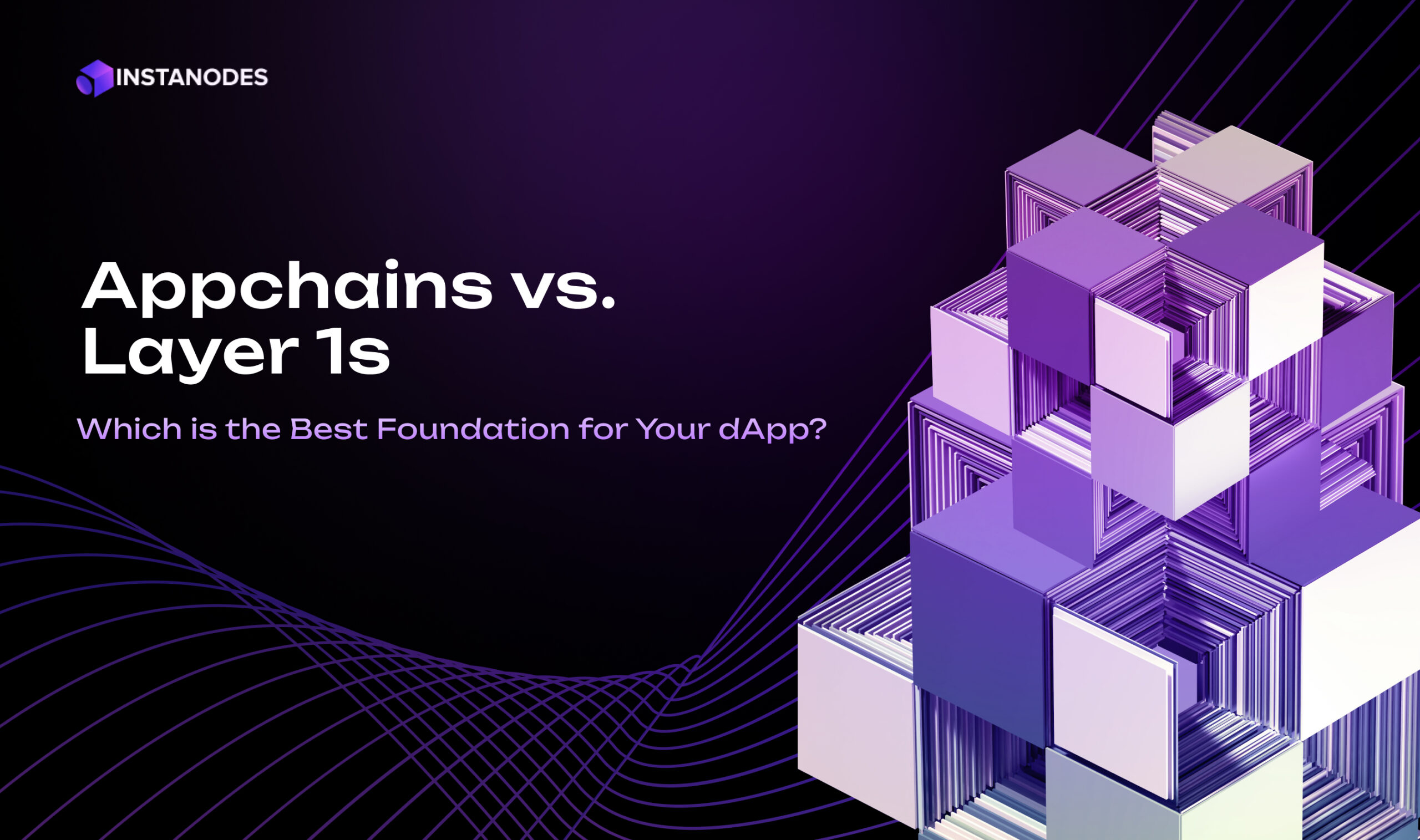Last month, I watched a promising DeFi protocol struggle for three days to get its cross-chain functionality working. Their development team spent weeks configuring nodes for Ethereum, Polygon, and Arbitrum, only to realize that maintaining everything in sync was about juggling flaming torches on a unicycle. Sound familiar?
If you’ve built anything in Web3 lately, you know the drill. What started as a “simple” multi-chain dApp quickly becomes an infrastructure nightmare. Your Ethereum node goes offline during a critical transaction period. Your Polygon connection starts lagging by 20 blocks. Your developers are spending more time troubleshooting network issues than actually building features.
Here’s the thing: while you’re wrestling with node management, your competitors are shipping features using Nodes as a Service. They’re deploying to five networks in the time it takes you to sync one. They’re scaling without breaking a sweat while your team debates whether to hire a DevOps engineer or just pray your current setup holds together.
Take Uniswap, for example. It didn’t build their multi-chain expansion by managing dozens of blockchain nodes in-house. It leveraged a professional RPC node provider to rapidly deploy across Ethereum, Polygon, Arbitrum, and Optimism. Same with Aave’s cross-chain lending protocol. They focused on financial restyling, not infrastructure headaches.
Web3 startups found that teams using professional nodes services shipped features 3x faster than those managing their own infrastructure. More importantly, they experienced 90% fewer critical outages during high-traffic periods.
The shift toward multi-chain isn’t slowing down; it’s accelerating. Users don’t care about your technical challenges; they want their transactions to work whether they’re on mainnet or Layer 2. This reality makes reliable blockchain Nodes as a Service not just a nice-to-have, but absolutely essential for staying competitive.
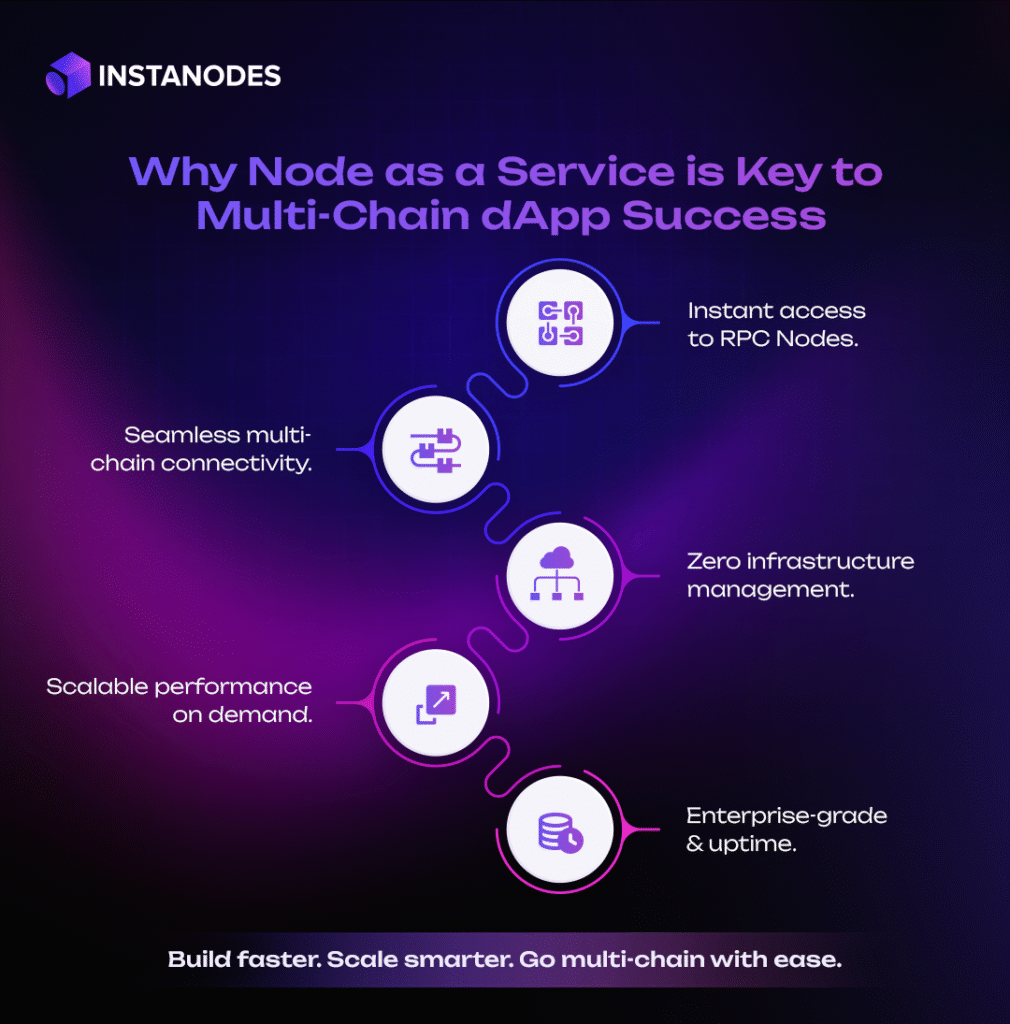
How Blockchain Nodes Power dApp Performance and Reliability
Think of blockchain nodes as the postal system for Web3. Every time someone clicks “Send Transaction” in your dApp, that request needs to travel through RPC nodes to reach the blockchain network. If your postal system is unreliable, letters get lost, deliveries are delayed, or post offices randomly close, which is noticed by you immediately.
Key ways nodes impact your dApp:
- Transaction processing speed: Slow nodes mean frustrated users watching spinning loaders.
- Data accuracy: Out-of-sync nodes serve stale information, causing failed transactions.
- Network reliability: Unstable connections lead to timeout errors and poor user experience.
- Geographic performance: Node location affects latency for users worldwide.
I’ve seen perfectly coded dApps fail because their node infrastructure couldn’t handle basic load. One NFT marketplace lost $50k in sales during a mint because their self-hosted Ethereum node crashed under traffic. Its smart contracts were impeccable, their UI was lovely, but their infrastructure failed them when they needed it most.
For applications across multiple chains, these issues compound on each network that you serve. Your Ethereum node might be humming along perfectly while your Polygon node falls 100 blocks behind, creating inconsistencies that break cross-chain functionality. Users don’t understand why their bridged assets aren’t showing up. They just know your app isn’t working.
Multi-chain complexity factors:
- Different sync requirements across networks (Ethereum vs BSC vs Avalanche)
- Varying block times affect data freshness
- Network-specific RPC methods and error handling
- Consensus mechanism differences impacting finality
Professional RPC nodes as a service solve this by maintaining specialized infrastructure for each network. They comprehend that 400ms block times of Solana demand optimizations other than 12-second blocks of Ethereum. They know which RPC calls are trustworthy in the load and which ones timeout when networks get congested.
The performance difference is measurable. Internal testing by major DeFi protocols shows 40-60% faster response times when switching from self-hosted to professional node RPC services. More importantly, the consistency is dramatically better. No more explaining to users why the app works fine on Tuesday but breaks every Friday during market volatility.
How Nodes as a Service Help Eliminate Infrastructure Overhead
Here’s what most founders don’t realize until it’s too late: running your own blockchain nodes isn’t just about the technical setup. It’s those 2 AM phone calls when your Ethereum node is not syncing anymore. It’s when your senior developer spends three days debugging why transactions are not working rather than implementing the feature that’ll get your next funding round closed.
Hidden costs of self-managed infrastructure:
- Engineering time: 20-30% of developer bandwidth goes to infrastructure maintenance.
- Opportunity cost: Features are delayed while fixing node issues.
- Scaling complexity: Traffic spikes require manual intervention and capacity planning.
- Security vulnerabilities: Nodes become attack targets without proper hardening.
- Compliance headaches: Regulatory requirements vary by jurisdiction.
Let me share a real example. A gaming startup spent six months building its Play-to-Earn economy, then discovered its self-hosted Polygon node couldn’t handle its launch day traffic. While scrambling to fix infrastructure, their biggest competitor launched a similar game using professional nodes services and captured the market.
Professional blockchain Nodes as a Service flip this equation entirely. Instead of your team becoming part-time DevOps engineers, they stay focused on what actually differentiates your product. When Axie Infinity needed to scale across multiple chains rapidly, it didn’t hire a node infrastructure team; it partnered with professional RPC node providers.
Benefits of managed nodes services:
- Instant multi-chain access: Deploy to new networks in a day, not weeks.
- Automatic scaling: Traffic spikes are handled with complete transparency.
- 24/7 monitoring: Your infrastructure is watched by professional teams around the clock.
- Geographic redundancy: Multiple data centers prevent single points of failure.
- Cost predictability: There are different packages, and you can choose a suitable plan to match your needs.
The financial impact is substantial. A normal Web3 company saves $15,000-$30,000 per month by employing managed node services rather than having dedicated DevOps expertise. What is more critical, though, is that they deliver features 60% faster since developers are not context-switching across application code and infrastructure debugging.
Security gets dramatically better, too. Professional node RPC providers invest millions in DDoS protection, intrusion detection, and compliance frameworks. They have security experts whose sole full-time duty is safeguarding blockchain infrastructure. It’s a skill set that’s prohibitively costly for individual startups to copy.
Unlocking Interoperability Through Managed Node Services
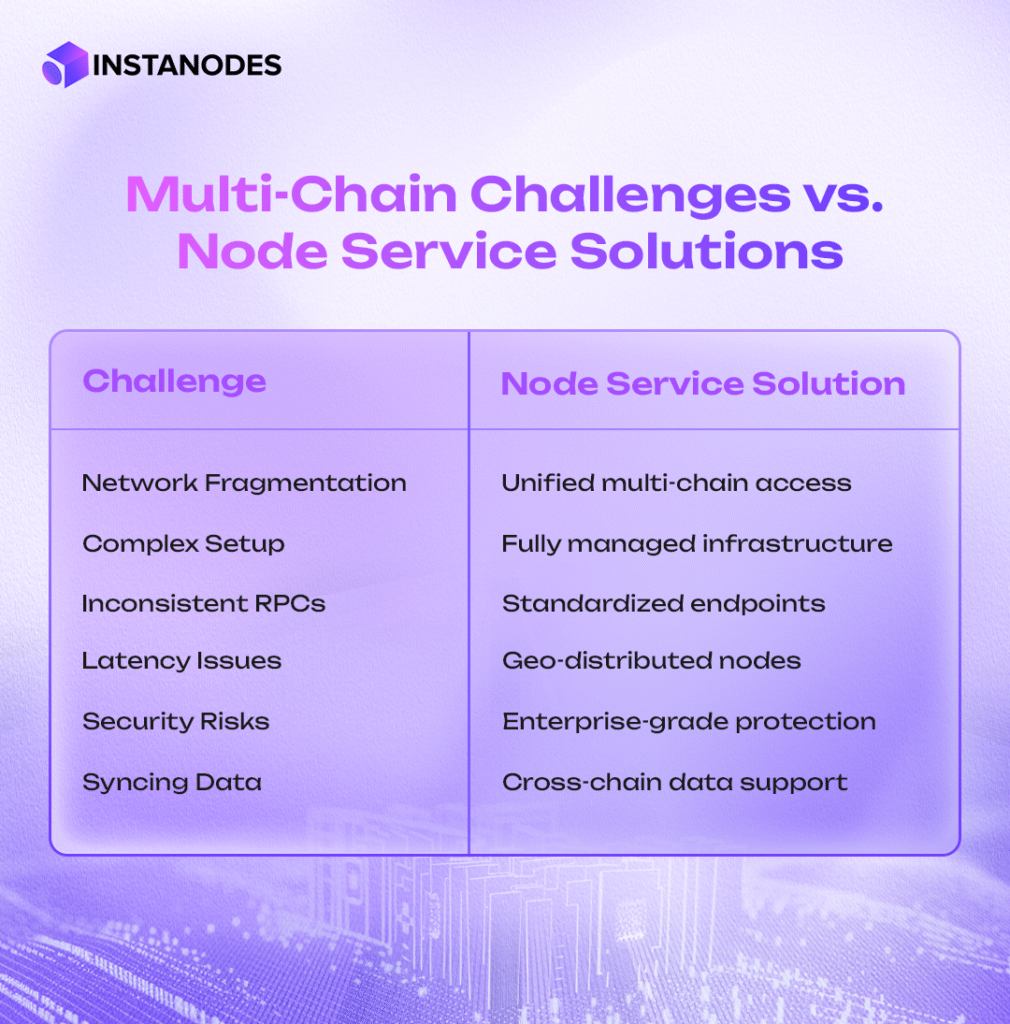
Creating fully interoperable dApps is like learning five disparate languages and expecting them to play nicely together. Ethereum communicates differently from Solana. Polygon is a bit oddball. Avalanche has disparate gas mechanisms. Most teams don’t appreciate this complexity until they’re up to their neck in integration hell.
Common multi-chain integration challenges:
- Protocol differences: Each network has unique RPC methods and data structures.
- Timing variations: Block confirmation times range from 400ms (Solana) to 12 seconds (Ethereum).
- Gas mechanisms: EIP-1559 vs fixed gas prices vs validator fees.
- Error handling: Network-specific failure modes and recovery strategies.
- Data consistency: Ensuring synchronized state across multiple chains.
I recently worked with a DeFi aggregator that wanted to support eight different chains. Their first attempt involved building separate integration logic for each network, a nightmare of duplicate code and maintenance overhead. Six months later, they were still debugging edge cases while competitors were shipping features.
RPC Nodes as a service providers remedy this by providing standardized APIs that abstract out the underlying complexity. Rather than needing to write special logic per blockchain, developers can utilize uniform interfaces that do the protocol translation behind the scenes.
How professional node services enable interoperability:
- Unified APIs: Single interface supporting multiple blockchain protocols.
- Cross-chain data synchronization: Real-time state updates across all networks.
- Intelligent routing: Automatic selection of optimal endpoints based on network conditions.
- Transaction simulation: Pre-execution testing to prevent failed transactions.
- Gas optimization: Network-specific fee estimation and optimization.
Take the example of a cross-chain yield farming protocol. Users want to view their positions on Ethereum, Polygon, and Arbitrum in one dashboard. With self-hosted nodes, this means keeping different connections, dealing with disparate data formats, and coping with non-synchronized response times. Professional node services offer normalized data feeds that make this easy.
Real-world interoperability benefits:
- Faster time-to-market: Deploy to new chains in days instead of months.
- Consistent user experience: Similar performance across all supported networks.
- Reduced development complexity: Focus on business logic instead of protocol differences.
- Better error handling: Professional monitoring catches issues before users notice.
The most successful multi-chain protocols realize that infrastructure complexity is their nemesis. They rely on managed node services to abstract away the technical pains, enabling their teams to work on building value for users instead of fighting with blockchain protocols.
Why You Can’t Match a Professional RPC Node Provider
Let me be blunt. Assuming you can compete with professional node infrastructure using your in-house team is similar to assuming you can create a better AWS in your garage. The chasm is not technical; it’s about scale, experience, and resources that single teams cannot economically duplicate.
What professional providers bring to the table:
- Massive scale: Processing billions of requests across hundreds of clients.
- Specialized expertise: Teams dedicated exclusively to blockchain infrastructure.
- Geographic redundancy: Data centers across continents with automatic failover.
- Enterprise security: Multi-million dollar investments in DDoS protection and monitoring.
- Regulatory compliance: Legal teams handling requirements across multiple jurisdictions.
Consider the numbers: Infura processes over 100 billion RPC requests monthly. Alchemy handles similar volumes while maintaining sub-200ms response times globally. These companies have 50+ engineers whose sole responsibility is optimizing blockchain connectivity. Your startup is not going to be able to compete with that level of investment and specialization.
Technical advantages you cannot replicate:
- Load balancing algorithms: Intelligent traffic distribution across multiple node clusters.
- Caching strategies: Optimized data storage, reducing blockchain queries by 60-80%.
- Real-time monitoring: Automated detection and response to network issues.
- Protocol optimization: Deep understanding of each blockchain’s performance characteristics.
- Capacity planning: Predictive scaling based on network activity patterns.
Here’s a real-world example: in Terra Luna’s collapse, network usage surged 10x average levels as users frantically closed positions. Professional RPC node provider scaled their infrastructure automatically to cope with the demand. Teams running their own nodes faced hours of downtime and failed transactions during the most critical moments.
Cost realities that make self-hosting impractical:
- Infrastructure investment: $50,000+ monthly for enterprise-grade multi-chain setup.
- Personnel costs: $200,000+ annually for qualified blockchain DevOps engineers.
- Bandwidth expenses: Terabytes of data transfer costs are mounting quickly.
- Security tooling: Enterprise DDoS protection and monitoring systems.
- Compliance overhead: Legal and audit costs for regulatory requirements.
The expertise gap is equally important. Professional node RPC providers employ specialists who understand the nuances of each blockchain network. They know that Ethereum Classic requires different optimization than the Ethereum mainnet. They understand how to handle Solana’s unique consensus mechanism efficiently. This knowledge takes years to develop and is constantly evolving.
When Ethereum moved to Proof of Stake, professional providers had been preparing for months, ensuring seamless transitions for their clients. Teams managing their own nodes often faced days of downtime while figuring out the new requirements. That’s the difference between having infrastructure as your core competency versus treating it as a necessary evil.
Choosing The Right RPC Node Provider For Seamless Web3 Connectivity
Picking an RPC node provider isn’t like choosing a hosting company. The wrong choice can literally break your dApp when you need it most. I’ve watched teams switch providers three times before finding one that actually delivered on their promises. Here’s what actually matters when evaluating nodes services.
Network coverage and depth:
- Supported blockchains: Does the provider support all networks you plan to use?
- Testnet access: Critical for development and staging environments.
- Archive nodes: Historical data access for analytics and debugging.
- Specialized endpoints: NFT metadata, DeFi-specific methods, trace APIs.
Don’t just look at the marketing list of “supported networks.” Dig deeper. Can they handle eth_getLogs queries efficiently? Do they support debug_trace Transaction for troubleshooting? Some providers claim Polygon support but can’t handle the high throughput requirements during network congestion.
Performance metrics that actually matter:
- Response times: Sub-200ms for standard RPC calls, measured globally.
- Uptime guarantees: 99.9% minimum with SLA penalties for downtime.
- Rate limits: Realistic throughput for your application’s needs.
- Geographic distribution: Edge locations in your users’ regions.
Ask for real performance data, not marketing claims. Request access to their status pages and monitoring dashboards. The best providers are transparent about their performance metrics because they’re confident in their infrastructure.
Pricing structures to understand:
- Package-based pricing – Pay for what you actually want. You can select the pricing plan according to your specific needs.
- Fixed monthly plans: Predictable costs with included request allowances.
- Enterprise contracts: Custom pricing for high-volume applications.
- Hidden costs: Setup fees, premium network access, enhanced support.
Integration and developer experience:
- SDK quality: Well-maintained libraries for your programming language.
- Documentation depth: Comprehensive guides, not just API references.
- Debugging tools: Request tracing, error analysis, performance insights.
- Migration support: Help switching from your current setup.
The best providers understand that switching node infrastructure is painful. They offer migration assistance, parallel testing environments, and gradual transition plans. If a provider just gives you an API key and wishes you luck, look elsewhere.
Support quality indicators:
- Response times: How quickly do they respond to critical issues?
- Technical expertise: Can support engineers actually debug blockchain issues?
- Proactive communication: Do they notify you about network issues before you discover them?
- Escalation paths: Clear procedures for urgent problems.
Red flags to avoid:
- Providers who can’t explain their infrastructure architecture.
- Companies that promise 100% uptime (impossible in blockchain).
- Services without transparent pricing or hidden contract terms.
- Providers without proper security certifications or compliance frameworks.
The smart approach is to test 2-3 providers with a subset of your traffic before committing fully. Set up monitoring for response times, error rates, and consistency across different networks. The provider that performs best under real-world conditions usually isn’t the cheapest option, but the reliability pays for itself when your users need your app to work.
Conclusion
The multi-chain future isn’t coming, it’s here. While you’re reading this, successful dApps are processing transactions across Ethereum, Polygon, Arbitrum, and a dozen other networks simultaneously. The teams winning this race aren’t the ones with the best infrastructure engineers; they’re the ones smart enough to focus on their core product while leveraging professional blockchain infrastructure.
Every day you spend managing nodes is a day your competitors spend building features users actually want. Every outage you experience because your Ethereum node decided to stop syncing is user trust you’ll never fully recover. Every time you delay launching on a new network because you don’t have infrastructure ready, you’re missing market opportunities that won’t come again.
The companies that will dominate Web3 over the next few years understand this fundamental truth: infrastructure is the foundation, not the product. Uniswap didn’t become the leading DEX by building the best node infrastructure, it built the best trading experience by leveraging professional RPC node providers for reliable connectivity. Mirror didn’t bring a change in publishing by managing blockchain nodes. It created an amazing creator platform while trusted partners handled the technical complexity.
The crux: the ones using professional Nodes as a Service consistently ship faster, scale better, and spend more time solving actual user problems. The ones managing their own infrastructure are constantly fighting fires instead of building the future.
Your users don’t care about your infrastructure architecture. They care about whether your dApp works when they need it. They want their transactions to go through quickly, their balances to update accurately, and their cross-chain transfers to complete without drama. Professional node RPC providers make this possible while your team stays focused on creating value.
Ready to stop fighting infrastructure fires and start building the future? Instanodes delivers enterprise-grade blockchain node infrastructure with 99.9% uptime, lightning-fast response times, and support for nearly 50 networks. Get started today!
